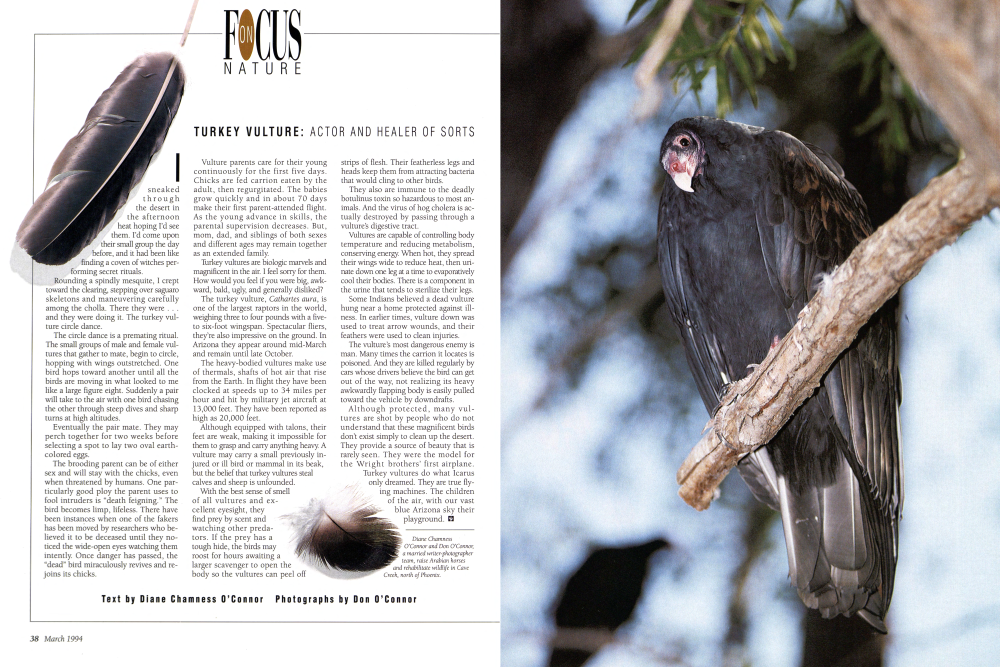Turkey Vultures

TURKEY VULTURE: ACTOR AND HEALER OF SORTS
sneaked through the desert in the afternoon heat hoping I'd see them. I'd come upon their small group the day before, and it had been like finding a coven of witches performing secret rituals. Rounding a spindly mesquite, I crept toward the clearing, stepping over saguaro skeletons and maneuvering carefully among the cholla. There they were . . . and they were doing it. The turkey vulture circle dance. The circle dance is a premating ritual. The small groups of male and female vultures that gather to mate, begin to circle, hopping with wings outstretched. One bird hops toward another until all the birds are moving in what looked to me like a large figure eight. Suddenly a pair will take to the air with one bird chasing the other through steep dives and sharp turns at high altitudes. Eventually the pair mate. They may perch together for two weeks before selecting a spot to lay two oval earthcolored eggs. The brooding parent can be of either sex and will stay with the chicks, even when threatened by humans. One particularly good ploy the parent uses to fool intruders is “death feigning.” The bird becomes limp, lifeless. There have been instances when one of the fakers has been moved by researchers who believed it to be deceased until they noticed the wide-open eyes watching them intently. Once danger has passed, the “dead” bird miraculously revives and rejoins its chicks.Turkey vultures are biologic marvels and magnificent in the air. I feel sorry for them. How would you feel if you were big, awkward, bald, ugly, and generally disliked? The turkey vulture, Cathartes aura, is one of the largest raptors in the world, weighing three to four pounds with a fiveto six-foot wingspan. Spectacular fliers, they're also impressive on the ground. In Arizona they appear around mid-March and remain until late October. The heavy-bodied vultures make use of thermals, shafts of hot air that rise from the Earth. In flight they have been clocked at speeds up to 34 miles per hour and hit by military jet aircraft at 13,000 feet. They have been reported as high as 20,000 feet. Although equipped with talons, their feet are weak, making it impossible for them to grasp and carry anything heavy. A vulture may carry a small previously injured or ill bird or mammal in its beak, but the belief that turkey vultures steal calves and sheep is unfounded. With the best sense of smell of all vultures and excellent eyesight, they find prey by scent and watching other predators. If the prey has a tough hide, the birds may roost for hours awaiting a larger scavenger to open the body so the vultures can peel off strips of flesh. Their featherless legs and heads keep them from attracting bacteria that would cling to other birds. They also are immune to the deadly botulinus toxin so hazardous to most animals. And the virus of hog cholera is actually destroyed by passing through a vulture's digestive tract. Vultures are capable of controlling body temperature and reducing metabolism, conserving energy. When hot, they spread their wings wide to reduce heat, then urinate down one leg at a time to evaporatively cool their bodies. There is a component in the urine that tends to sterilize their legs. Some Indians believed a dead vulture hung near a home protected against illness. In earlier times, vulture down was used to treat arrow wounds, and their feathers were used to clean injuries. The vulture's most dangerous enemy is man. Many times the carrion it locates is poisoned. And they are killed regularly by cars whose drivers believe the bird can get out of the way, not realizing its heavy awkwardly flapping body is easily pulled toward the vehicle by downdrafts. Although protected, many vultures are shot by people who do not understand that these magnificent birds don't exist simply to clean up the desert. They provide a source of beauty that is rarely seen. They were the model for the Wright brothers' first airplane. Turkey vultures do what Icarus only dreamed. They are true flying machines. The children of the air, with our vast blue Arizona sky their playground.
Already a member? Login ».